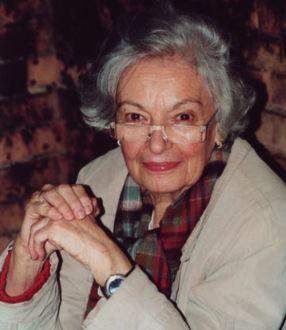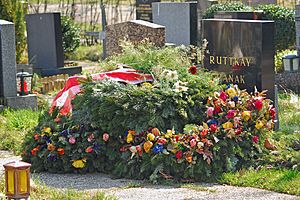Elisabeth Ruttkay facts for kids
Quick facts for kids
Elisabeth Ruttkay
|
|
|---|---|
 |
|
| Born |
Erzsébet Kiss
18 June 1926 |
| Died | 25 February 2009 (aged 82) Vienna, Austria
|
| Nationality | naturalized Austrian |
| Other names | Elisabeth Ruttkay-Hanák, Elisabeth Hanák-Ruttkay |
| Occupation | archaeologist |
| Years active | 1962-2009 |
| Known for | Neolithic and Bronze Age studies in Austria |
Elisabeth Ruttkay (born June 18, 1926 – died February 25, 2009) was a famous archaeologist. She was born in Hungary but later became an Austrian citizen. Elisabeth Ruttkay was an expert in the New Stone Age and Bronze Age periods in Austria.
She won important awards for her work. These included the Lower Austria Promotion Prize and the Austrian Cross of Honour for Science and Art.
Contents
Early Life and Education
Elisabeth Ruttkay was born Erzsébet Kiss on June 18, 1926, in Pécs, which was then part of the Kingdom of Hungary.
She got married to Zoltan von Ruttkay in 1943 when she was 17 years old. She finished high school the next year. Elisabeth studied Hungarian language and literature at two universities in Budapest: Pázmány Péter Catholic University and Eötvös Loránd University. She earned her diploma there.
Her Career as an Archaeologist
After finishing her studies, Elisabeth Ruttkay worked at Pázmány Péter University. She worked with Professor Miklós Zsiray in the Institute for Finno-Ugric Languages. She stayed there until Professor Zsiray passed away in 1955.
The next year, Elisabeth and her husband moved to Austria. For two years, she was the director of the Hungarian Gymnasium (a type of high school) in Innsbruck. In 1958, she went back to university. She studied prehistory, early history, and art history at the University of Vienna with Professor Richard Pittioni.
After her studies, Elisabeth Ruttkay became an Austrian citizen in 1961. The next year, she started working at the National Museum of Burgenland in Eisenstadt. She worked there for six years.
Working at the Vienna Museum
In 1968, Elisabeth Ruttkay began working at the Vienna Museum of Natural History. She first helped to organize and pack old artifacts for the Prehistoric Department.
In 1970, she started her own archaeological digs at Jennyberg near Mödling. She focused on how the Neolithic period developed in Central Europe. In the same year, she wrote a report about a New Stone Age chert mining site. This site was at Antonshöhe near Mauer. It was one of the first industrial sites in Lower Austria and the only deep-shaft mine from that time in the country.
In the early 1970s, Ruttkay began digging at Prellenkirchen. This work led to a closer look at Austria's Linear Pottery culture. This culture is known for its pottery with straight line decorations. In 1976, she created the term "Vornotenkopfkeramik" (Before music note ceramics). This term described the oldest groups of the Linear Pottery culture in Austria. These potters used simple line patterns and added plant material to their clay.
Doctorate and Later Research
Elisabeth Ruttkay earned her doctorate in Philosophy in 1979 from the University of Vienna. Her main paper was about "The Neolithic painted ceramics in Austria." She continued to research the timeline of ancient Austrian cultures.
Her studies covered many different ancient groups. These included the Moravian-Eastern Austrian Group of painted pottery and the Bronze Age Attersee Group. The Attersee Group and Mondsee Culture lived near lakes in Upper Austria. Their pottery had designs like arcs, lines, zigzags, sun discs, and triangles. Ruttkay's work on the Mondsee Culture was very important. It created a timeline for this culture that is still used today. Later, scientists confirmed her timeline using radiocarbon dating.
In 1982, Elisabeth Ruttkay's first husband passed away. The next year, she became the High Counselor of the Prehistory Department. She also became the director of the museum's library. In 1983, she married Tibor Hanák, a philosopher she had known from her teaching days. While she was library director, between 4,000 and 5,000 new books about prehistoric topics were added to the collection.
She retired from the department in 1991. However, she kept doing her research. She finished her analysis of the Wachberg phase in 1995 and the Neusiedl phase in 2002. She continued to publish her work on Austrian cultural development until she passed away.
Death and Legacy
Professor Johannes-Wolfgang Neugebauer, an expert in prehistory, called Elisabeth Ruttkay the "grande dame of Austrian Neolithic research." This means she was a very important and respected figure in the study of Austria's New Stone Age.
Her important work was recognized with many awards. In 1987, she received the Lower Austria Promotion Prize. This award honors people who help develop Lower Austria. The next year, she received the Austrian Cross of Honour for Science and Art.
Elisabeth Ruttkay passed away on February 25, 2009, in Vienna. She was cremated, and her ashes are buried at Feuerhalle Simmering.
See also
 In Spanish: Elisabeth Ruttkay para niños
In Spanish: Elisabeth Ruttkay para niños


